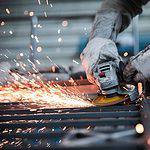Today we will learn about cone clutch, its principle, construction, advantage, disadvantages and its applications. Cone clutch is one type of friction clutch which is used to engage and disengage engine shaft to the transmission box shaft during changing gear ratio. It is one of the oldest types of clutch used in automobile industries. This clutch is easy to engage and disengage compare to positive displacement clutches which were used before invention of friction clutches.
Cone clutch is used to transfer higher torque than same size of plate clutch due to greater contact area. This clutch is used where high torque to be transfer at low rotating speed. This article gives you all information about this clutch working, application and advantages and disadvantages.
Cone Clutch:
Principle:
As we have mention in earlier section of this article, cone clutch is a one type of friction clutch. So this clutch works on the principle of friction. If two rotating surfaces which are lined with friction material bring in contact in rotating condition, they both start revolving at same speed. This is basic of all friction clutches.
In a cone clutch, there are a outer cone which is connected to driving shaft and an inner cone which is connected to driven shaft. There are some friction lining at inner section of the outer cone and outer section of the inner cone. These both cone are bring in contact to transfer energy from driving shaft to driven shaft.
Construction:
A cone clutch consists following components.

Outer Cone:
Outer cone which is sometime known as female cone is connected to the flywheel or the driven shaft of the engine. This part of clutch is always in rotating condition with the engine shaft. The inner part of the outer cone is lined with friction lining which makes frictional contact with the inner cone and allow to rotate driven shaft at same speed of driving shaft.
Inner Cone:
Inner cone which is sometime known as male cone is connected to the transmission shaft or the gearbox. The outer part of the inner cone is lined with friction lining which allow frictional contact between inner cone and outer cone. This part of the clutch remains in contact with the outer cone with the help of pressure springs. When the driver want to disengage transmission box from engine, he pushes the clutch pedal which disengage inner cone to outer cone thus disengage engine to transmission box.
Pressure Springs:
Pressure springs or simply called springs are used to make contact between male cone to female cone when the clutch pedal is released. When the driver press the clutch pedal it compresses this spring which allow to disengage clutch.
Sleeves:
Part of the clutch on which the inner cone mounted and performs to and fro motion during engagement and disengagement of clutch is called sleeve.
Working:
Working of a cone clutch can be summarized into following points.
At the starting of the vehicle, the clutch pedal is pressed by the driver which allow to compress the pressure springs thus the inner cone slightly move far from the outer cone. This will break the contact between inner cone and outer cone thus the clutch is in disengage position. Any rotation of the engine shaft or driving shaft does not transfer to transmission shaft or driven shaft.
Now the driver want to engage the transmission line thus he slowly released the clutch pedal. This will allow to pressurized spring to expand which pushes inner cone towards outer cone and allow to make contact between them. A frictional force acts between inner side of outer cone and outer side of the inner cone which allow them to rotate at same speed. Thus the engine shaft and transmission shaft allow rotating at same speed and the clutch is called in engage position.
Advantages and Disadvantages:
Advantages:
Less wear and tear compare to positive displacement clutch.
It is silent in operation.
The normal force acting on the contact surface is larger than the axial force generated by the springs.
Comparatively higher torque can be transmitted than same size of plate clutch.
Disadvantages:
Operation of the clutch is highly depended on the cone angle. If the cone angle is smaller than 20 degree, it becomes difficult to disengage the clutch.
Frequent maintenance required because the small amount of wear on the cone surface results in a considerable amount of the axial movement of the inner cone.
This is all about cone clutch. If you have any query regarding this article, ask by commenting. If you like this article, don’t forget to share it on social networks. Subscribe our website for more informative articles. Thanks for reading it.




